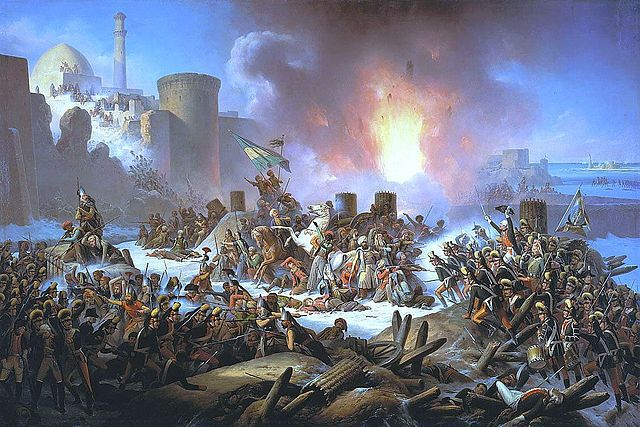Three Asian Empires emerged during the Early-Modern Era (1450-1750). While the Spanish, Portuguese, British, French, and Dutch constructed colonies all over the Western Hemisphere, the Qing Dynasty created a Chinese empire; the Moghul created a somewhat unified Subcontinent Empire; and the Ottoman Empire unified Christians and divided Muslims under Turkish control. As these empires developed, they had to find ways to subjugate populations.
Empire building requires conquering people and their cultures. How the conquering happens and to whom has been different for each empire. Sometimes force is used and other times complacency is the mode to which citizens subjugate themselves. For people that have survived in the same manner for thousands of years, when a new power overtakes it, the old society simply vanishes. Many times the cultures of the conquered mix with the cultures of the conquering, creating a new and much more diverse culture. The Qing, Moghul, and Ottoman empires were significant cross-cultural encounters during the early modern age.

The Qing Dynasty 1644-1913
The Qing dynasty made China an empire. Emperor Yongle launched a massive fleet in 1405, called Starfleet, consisted of more than 300 ships with 27,000 crew. Included were physicians, government officials, astrologers, high-ranking eunuchs, carpenters, tailors, accountants, merchants, translators, cooks, and thousands of soldiers and sailors. Over the next 28 years, seven more fleets would launch and travel to ports in Southeast Asia, Indonesia, India, Arabia, and East Africa. Zheng He, a Muslim eunuch, captained the fleet.
The goal of the fleet was to expand China’s trade and tribute system. Several rulers returned to China with the fleet bringing with them items of tribute. Exotic items such as ostriches, zebras, and giraffes went to the Emperor as tribute. The expeditions of Zheng He expanded China’s trade and established it as a power in the Indian Ocean. Unlike European powers, the Chinese did not conquer new territories or establish new settlements. Instead, they intervened in local disputes but maintained their objective of expanding trade. In 1433, the voyages came to an abrupt end, concluding China’s dominance in maritime trade.
During the seventeenth and eighteenth centuries, China turned its focus to building an overland empire on its northern and western frontiers. The Qing, or Manchu, Dynasty (1644-1912) undertook this enormous expansion. Originating from Manchuria, north of the Great Wall, the Qing Dynasty was of a foreign and nomadic origin. The continuing eastward expansion of Russia and the revived effort by the western Mongols made the Qing Dynasty nervous. To add a buffer, the Qing required more land to halt another Mongolian invasion and to ward off the Russians.
For centuries, the nomadic people of Mongolia, Xingjian, and Tibet had traded, presented tribute, and went to war with each other. These people were well known to one another and had an understanding of their significant cultural differences. In 1680, the Qing Dynasty began an eighty-year military effort to bring these diverse regions under their control. Clearly, residents of Mongolia, Xinjiang, and Tibet did not subject themselves easily to central rule. The use of weaponry, war tactics, and the need for warriors over an eighty-year period does little to fully grasp the carnage that must have ensued.
Finally, the Qing dynasty completed its unification in 1760. Mongolia was added in 1697, Tibet in 1720, and Xingjian added in the 1750s. China was now a Central Asia empire. The new areas were ruled separately from China through a court of Colonial Affairs. In ways vastly similar to the Europeans in the Americas, local officials became agents of the dynasty in the colonial government. Mongol aristocrats, Muslim officials, and Buddhist leaders were granted power as agents for the Qing dynasty.
As with other colonial regimes, local leaders were often corrupt. Some required people to pay extra taxes or demanded extra labor, outraging local populations. Some colonial officials adorned themselves with peacock feathers, decorated their hats with gold buttons, and wore the Manchu hairstyle as a way to imitate the Chinese ways, enraging the local people who did not want to be under Chinese control.
Unlike their European counterparts, the Chinese or Qing officials did not seek to assimilate the native populations. A reason for this may have been that the Qing dynasty came from Manchuria and were nomadic. As a nomadic people, they would have also participated in a cycle of tribute, trade, and war, thus providing the Qing with a respect and understanding for cultural differences. In fact, the Qing placed restrictions on Chinese merchants and immigrants from entering into Mongolian areas for fear of softening the fighting Mongol spirit, something that the Chinese may have needed in the future.
The present-day boundaries of China are much as they were when the Qing unified with Mongolia, Tibet, and Xinjiang. Many of these people have retained their culture and religious identities with some advocating for autonomy or gaining independence.
Prior to the Qing dynasty expansion, Central Asia was a crossroads of trade along the Silk Roads, welcoming all of the world’s major religions and ideologies. Once the Qing dynasty added Mongolia, Tibet, and Xinjiang oceanic trade took a backseat to overland trade. In the process, the nomadic pastoralists, who provided an alternative to settled farming and had been around since the second millennium BCE, were eradicated permanently.

